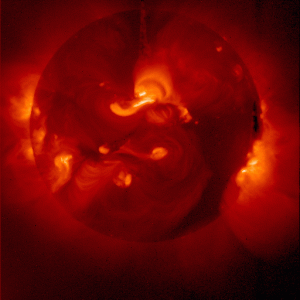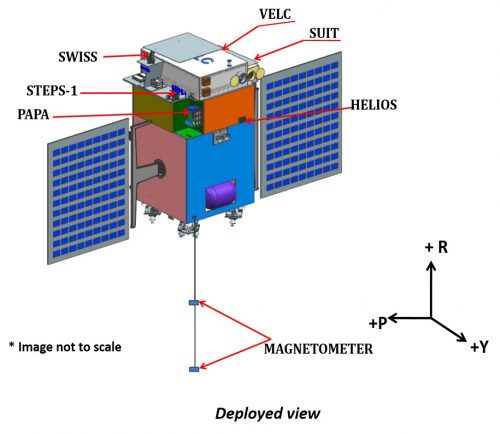Aditya L1: What India’s Maiden Space Mission to Study the Sun Will Look For
It will try to figure out why the outermost layer of the Sun is a million degrees hot among other things.

Aditya means the Sun in the Sanskrit language. It is our nearest star and is located at a distance of one Astronomical unit and sunlight takes about eight and a half minutes to reach us on Earth. Sun is the natural source of energy, heat and light. It is impossible to imagine life on Earth without our Sun.
Numerous processes which harvest sunlight occur during the daytime such as photosynthesis in plants, evaporation from water bodies, charging of solar cells, generation of vitamin D by our skin etc. Human beings have the innate curiosity to understand how Nature works. The firmament is not an exception and our ancestors have tried to understand these cosmic objects with the available resources and technology during contemporary times. We still wonder how our Sun shines and what goes on inside its million degrees hot core? What are the various explosive phenomena occurring in the vicinity of our Sun? How can changes in the Sun’s behaviour affect life on our Earth?

The radius of our Sun is about 100 times than that of the Earth and weighs about 10^30 kg (i.e. 10 followed by 30 zeroes! Almost 3,00,000 times heavier than the Earth). The visible surface of the Sun is known as the photosphere and is about 6000 degrees hot! But the inside of our Sun is even hotter with temperatures of the order of about a few million degrees where hydrogen undergoes fusion to form helium nuclei and releases an enormous amount of energy in the process. The Sun emits across a wide band in the electromagnetic spectrum ranging from gamma rays up to radio waves.
On disc view of the Sun in X-rays

On disc view of the Sun in Ultraviolet (UV)

So, one may wonder how obtaining multi-wavelength observations of our Sun helps us (besides appreciating the cosmetic beauty of our star!)? Electromagnetic radiations emanating from our Sun are carriers of vital information relating to numerous phenomena (such as energy generation in the Sun, occurrence of explosive events such as flares and coronal mass ejections which are the biggest explosions in our solar system!) happening in our star. These explosive events if directed towards us can severely impact life on Earth by damaging satellites, causing power grid failures, disrupting communication etc.
You might also enjoy: In a First, Indian Student Team Project Bags Second Position at NASA’s Space App Challenge
India has some ground-based observatories such as the Kodaikanal Solar Observatory (KSO) and the Udaipur Solar Observatory (USO) in optical regime; the Giant Metrewave Radio Telescope (GMRT) and the Gauribidanur Radio Observatory in radio window. Recently, the solar observations dating backing to as far as 1906 were digitised and released publicly by the digitisation team at IIA, Bengaluru and KSO, Kodaikanal. Here is a time-lapse image of our Sun (1909-2007) made from the archived data.

The Aditya-L1 space mission will be the maiden space observatory of India dedicated to study the Sun. As of now the mission is planned for launch around 2019-2020.
The mission will also India’s first mission placed at the Lagrange point L1. L1 is a vantage point as it would provide 24×7 unobstructed views of the Sun. The space mission will carry seven payloads viz. Visible Emission Line Coronagraph (VELC), Solar Ultraviolet Imaging Telescope (SUIT), Aditya Solar wind Particle Experiment (ASPEX), Plasma Analyser Package for Aditya (PAPA), Solar Low Energy X-ray Spectrometer (SoLEXS), High Energy L1 Orbiting X-ray Spectrometer (HEL1OS) and Magnetometer.
You might also enjoy: India to Send Humans into Space? ISRO Readying GSLV Mk III for Landmark Flight!
These instruments will enable us to understand some mysteries such as why the outermost layer of the Sun is million degrees hot (known as the coronal heating problem), mechanism of generation of solar storms and developing prediction capabilities to protect resources on Earth such as satellites, power grids etc., solar wind acceleration etc.

The scientific payloads are being designed and made by different teams from various Indian Institutes viz. IIA Bangalore, IUCAA Pune, PRL Ahmedabad, VSSC Thiruvananthapuram, ISAC Bangalore and LEOS Bangalore.

Aditya L-1 will be launched onboard ISRO’s PSLV-XL rocket from India’s space port in Sriharikota and would certainly help us to learn about the known unknowns and enable us to improve our understanding how our Sun works.
For more information, write to Promote Science and visit us online.
Like this story? Or have something to share?
Write to us: [email protected]
Connect with us on Facebook and Twitter.
NEW: Click here to get positive news on WhatsApp!
If you found our stories insightful, informative, or even just enjoyable, we invite you to consider making a voluntary payment to support the work we do at The Better India. Your contribution helps us continue producing quality content that educates, inspires, and drives positive change.
Choose one of the payment options below for your contribution-
By paying for the stories you value, you directly contribute to sustaining our efforts focused on making a difference in the world. Together, let’s ensure that impactful stories continue to be told and shared, enriching lives and communities alike.
Thank you for your support. Here are some frequently asked questions you might find helpful to know why you are contributing?


This story made me
-
97
-
121
-
89
-
167











